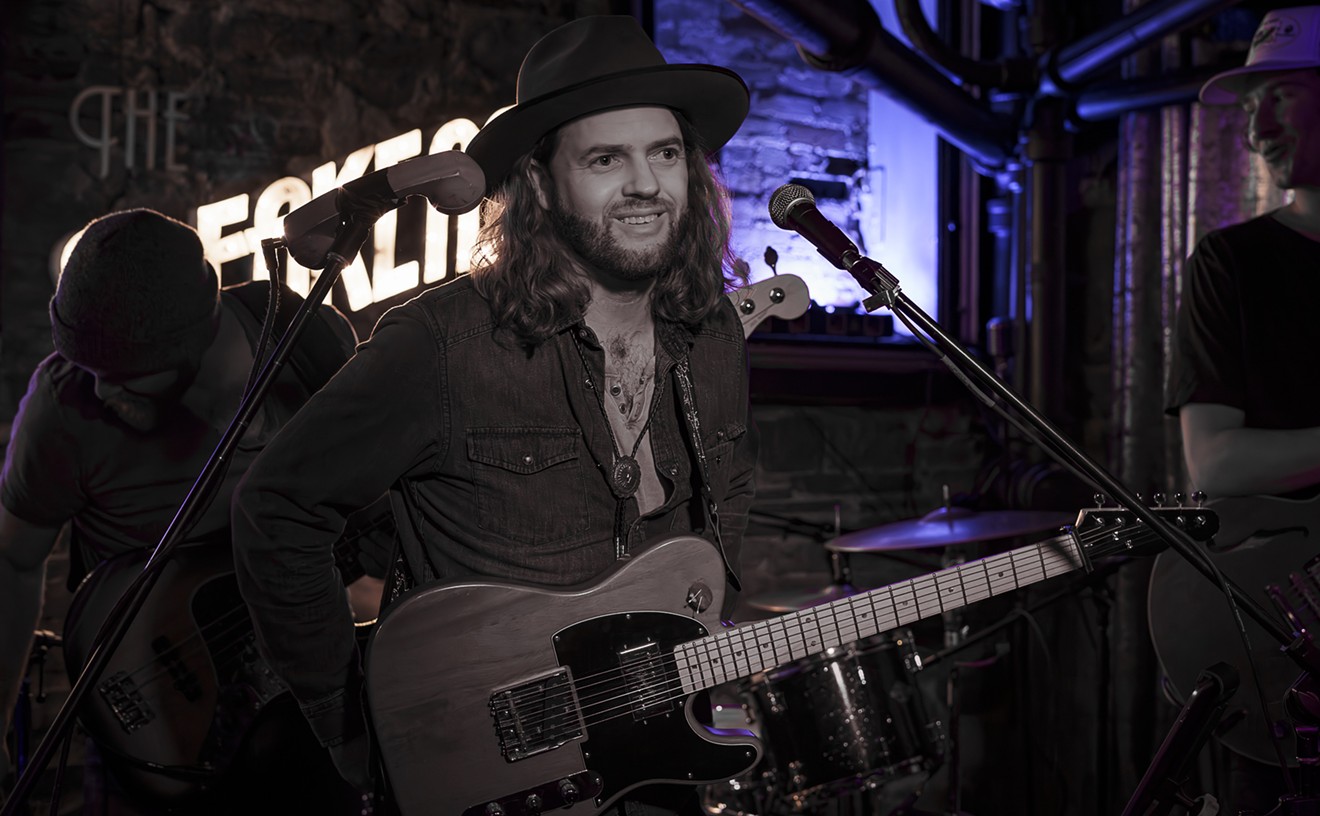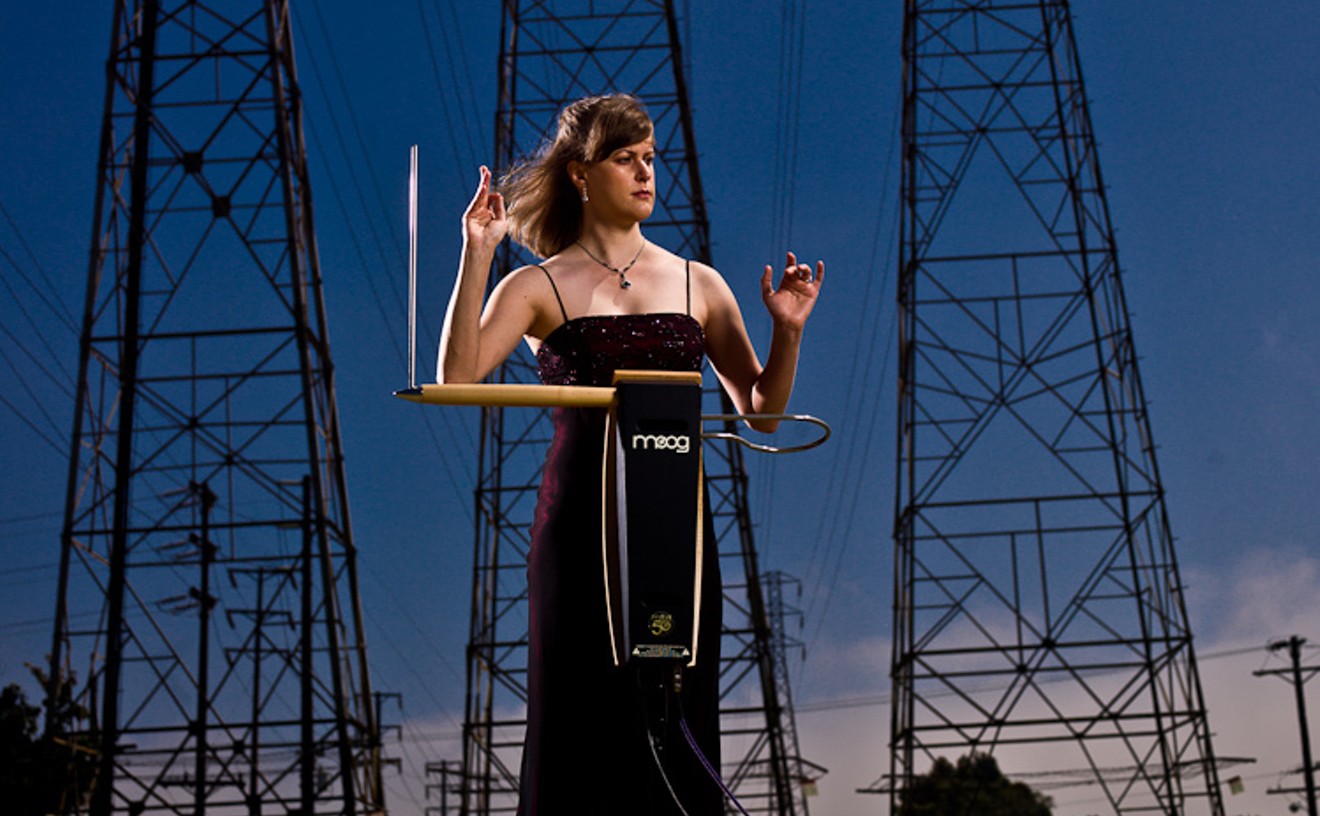If any combo exemplifies this phenomenon, it's Lothar and the Hand People. Formed in Denver back in 1965, the outfit lasted for just short of five years, and during that span, its modest recorded output -- the players released just two albums and a handful of singles -- made ripples, not splashes. Perhaps its biggest moment came when Dick Clark played the Lothar song "Machines" during the rate-a-record segment of an American Bandstand episode; according to keyboardist Paul Conly, the collective's unofficial historian and, like lead singer John Emelin, a current Denver resident, the two teens who critiqued the tune hated it, with one asking Clark what was the lowest score she could give.
But if such reactions eventually doomed Lothar's career, they couldn't undermine its pop-historic significance. The Hand People, you see, were the first rockers to tour and record using synthesizers, thereby inspiring the generation of electronic music-makers who immediately followed them -- and they remain a touchstone for many contemporary electro-warriors. On "It Doesn't Matter," a cut from their platinum-plus 1997 album Dig Your Own Hole, the Chemical Brothers sampled the Lothar track "It Comes on Anyhow," arguably generating more income for Conly and company than all of their previous recordings combined. And late last year, Razor & Tie, among the country's most prominent re-issue labels, put out Presenting...Lothar and the Hand People, a disc that compiles "Machines," "It Comes on Anyhow," and seventeen other vintage Lothar efforts. "It's been great in so many ways," Conly says of this unexpected attention. "We don't know if it's really building a new audience -- but we'd like it to."
As Conly tells it, Lothar fell short of stardom firsthand thanks to a string of near-misses and raw luck. By contrast, Emelin has a more straightforward explanation for the Hand People's failure to captivate the masses: "We were a little too far ahead of our time."
Emelin, who was born in Mamaroneck, New York, got involved in the folk-music scene while he was in high school, and one of the first things he did upon arriving in Colorado to attend the University of Denver was form a jug band. But a trip with Richard Willis, his roommate and fraternity brother, to see the Rolling Stones in Chicago turned him on to the joys of electricity. Back at DU, the pair decided to pull together a rock band of their own, recruiting a couple of fellow students, bassist Rusty Ford and drummer Tom Flye, during the rush process, and later adding guitarist Kim King, then a fixture at the Denver Folklore Center, the hangout for up-and-coming musicians of the day. Willis, in classic hippie fashion, came up with the band's appellation while he was sleeping; he had a dream in which an enslaved race called the Hand People was saved by a hero named Lothar, and when he related the scenario to his fellows, who'd been stumped in their search for a trippy handle, the moniker stuck. Only later did they decide that a theremin owned by Emelin was actually the group's namesake. "People would always ask, 'Who's Lothar?', and we wouldn't know what to tell them," Conly says. "But finally we realized that Lothar had been there all along."
The Hand People rapidly put their fingerprints on the Denver music community. "Our timing was good," Emelin says. "We were long-haired at a time when there were only one or two other long-haired bands in town; the rest were old-fashioned greaser bands. So we hit the scene with a more modern look, and that propelled us to local fame right away." Yet despite the swarms of DU students and assorted tastemakers who'd line up outside the Exodus (a 3.2 bar with an interior Conly describes as "a sparkly bat cave") whenever the Hand People were scheduled to play, Emelin didn't take the group all that seriously. But that changed after a New Year's Eve date in Aspen that marked King's concert debut. "It was one of those shows where people were throwing quart bottles of beer on the floor for fun," he recalls. "We were so thrilled with the response that three of us called our parents on New Year's Day to tell them we were going to drop out of college."
Willis wasn't one of these rock rebels: While the rest of the Hand People decided to commit themselves to the band full-time, he chose to do the responsible thing and stay in school. (He apparently went through a lifestyle change later; Emelin says that when last he heard about Willis, around fifteen years ago, he was "some kind of a healer.") After a series of auditions, they hired Conly, a Denver-area native who fancied himself a jazzbo at the time, and returned to area stages. Soon thereafter, Conly convinced Emelin to play his theremin live for the first time, and the eerie, quavering tone of the device became the Hand People's aural signature -- although not always to the benefit of everyone in the audience. "We were at the Exodus one night, and whenever I'd play a theremin solo, this one guy would start thrashing around," Emelin says. "He seemed to be going into ecstatic paroxysms. But as it turned out, he had a metal plate in his head, and the theremin was causing some kind of horrible short in his nervous system. When we found out, we felt terrible."
Back then, like today, most local musicians felt that their odds of being discovered went up tremendously if they got out of Denver. So after opening for the Lovin' Spoonful (the show was supposed to take place at Red Rocks, but to the band's chagrin, inclement weather forced a move to the Denver Coliseum), the Hand People relocated to New York. They soon earned a supposedly steady gig at Trude Heller's, a club that had gained notoriety, Emelin points out, because Linda Bird Johnson, daughter of then-president Lyndon Johnson, had danced there with actor/suntan artisan George Hamilton -- but they were sacked just as quickly, for talking too much between numbers. So they shifted over to the Nite Owl Cafe, a Greenwich Village spot that brought them into contact with a slew of up-and-coming musicians, including Jimi Hendrix, who was headlining at a joint around the corner, billed as Jimmy James.
Shortly thereafter, Lothar experienced the first of its close calls. Hendrix and the Hand People (particularly King) became buddies, jamming together on a regular basis and earning a reputation that caught the attention of Linda Keith, a talent scout for Chas Chandler, a member of the British act the Animals as well as a budding entrepreneur. Chandler arranged to catch Lothar and Hendrix during one evening, but he arrived at the Nite Owl just as the Hand People's first set was ending. Conly says Chandler chatted with the musicians during the break, promising to catch their second set of the evening after eyeballing Hendrix. "Then he left," Conly allows, "and never came back." The reason? Chandler was blown away by Hendrix, whom he took with him to England, remade as a psychedelic guitar god and set on his way to international acclaim.
At first, this turn of events didn't seem like that big a deal, since Lothar was being courted by a bevy of labels, many of which were making a belated attempt to cash in on the new, freaky rock sound. The musicians had a private audience with Atlantic chairman Ahmet Ertegun, did a test recording for Columbia Records and received a big, fat offer from Elektra Records, a fledgling independent that promised to throw all its weight behind the band. Close call number two: When Lothar deferred, Elektra put the same commitment behind another group, called the Doors.
The Hand People, meanwhile, inked with Capitol Records in large part because it was the U.S. imprint of the Beatles, a favorite of theirs. But the company was so massive that the quintet promptly slipped to the bottom of the priority list. Their first Capitol single, "L-O-V-E (Ask For It By Name)," produced by Dick Weissman, another longtime Denver music type, was a charmingly eccentric ditty that included a "talking" theremin; Emelin rigged up a tube to the contraption and spelled out "love" in the background throughout the song. But although "L-O-V-E" received some regional airplay, it never caught on, and neither did subsequent 45s such as "Comic Strip" and "Let the Boy Pretend."
Despite these disappointments, Capitol ultimately allowed the boys to make an album, providing them with the princely budget of $8,000 to do so. As producer, they chose a complete novice, Robert Margouleff, mainly because he had access to the country's largest Moog synthesizer and a roomy soundstage, where he'd been doing engineering work for commercials and TV shows such as Star Trek. Margouleff went on to an impressive career, overseeing timeless albums such as Talking Book and Innervisions for Stevie Wonder, who was much influenced by Margouleff's synth mastery, and working as a producer, engineer or performer with acts as diverse as Quincy Jones, David Sanborn, Devo and 2 Live Crew. But when he was assisting the Hand People, Margouleff was forced to overcome numerous obstacles that he wouldn't face later -- mainly recording equipment that was "crude and far from state of the art," Conly says.
The result, 1968's Presenting...Lothar and the Hand People, is definitely a product of its time. The Razor & Tie compilation, which juxtaposes the entirety of the debut platter with the early singles, seesaws back and forth between a giddy variety of approaches; for instance, "This Is It," which has an almost country-rock feel, leads to the late-period Beatle-isms of "This May Be Goodbye," the trippy touches that accent "Kids Are Little People" and "Ha (Ho)," and a 47-second-long cover of the "Woody Woodpecker" theme that seems to have been cut under the influence of massive amounts of helium. The best moments are "It Comes on Anyhow," a ripe sonic collage in the spirit of "Revolution No. 9"; "Paul, in Love," a Moog doodle à la Dick Hyman in his "Minotaur" phase; and "Machines," a mating of Captain Beefheart clanging and synth experimentation that was named one of the 100 finest psychedelic-rock songs ever in a list published by the British mag Mojo in 1997.
Such plaudits came too late to help Presenting, which tanked, and the following year's Space Hymn, which suffered much the same fate and is now out of print. Ultimately, consumer indifference, coupled with distribution problems and bad blood with a vindictive former manager that caused the band to be all but blacklisted in New York, convinced the players that they should move on to other pursuits. Drummer Flye became an engineer whose credits include the original Woodstock album and discs by the Grateful Dead and other acts with whom Lothar once rubbed shoulders. Bassist Ford earned his keep as a New York-based producer of television commercials. And guitarist King, who helped Hendrix build his Electric Ladyland studio, is now a busy Webmaster, but he still finds time to stroke his ax in New York clubs on occasion.
Conly, meanwhile, put together the music for a play by Sam Shepard (Shepard pounded the drums for an in-theater combo that was billed as Lothar and the Hand People and was a part of the story) before setting up a computer music lab at Harvard -- a forward-looking venture that came a-cropper after Conly "fried" a prototype synthesizer worth approximately $100,000. Just in time, he received a call from Emelin, who'd returned to Colorado as part of the trendy back-to-the-country movement; he suggested that together, he and Conly could build a log house in Aspen big enough for both their broods. They did a good job: Emelin eventually sold the cabin they'd assembled to Jimmy Buffett, who in turn peddled it to once-and-former Eagle Glenn Frey.
During the mid-'70s, Conly and Emelin combined forces again on a video-music project -- another prescient idea they came up with before they could benefit from it. After that business went bust, Emelin drifted through a number of careers, even running a factory that made air-dried, vegetarian backpacking food; he's currently a real-estate appraiser, working mostly in the mountain towns outside Denver. For his part, Conly has made his living from music. His credits include getting one piece onto an edition of Sesame Street and scoring the 1984 children's film Kid Colter.
Emelin and Conly have also continued to write songs together over the years, and they hope that the renewed interest in Lothar might create a market for the first new Hand People collaborations in three decades. A Web-site prototype created by King is on the Internet right now (www.lotharandthehandpeople.com) and features an impressive gig list (Lothar once played a party for the late columnist Earl Wilson that was attended by Johnny Carson and Barbra Streisand), and a gallery of posters and photographs by the likes of renowned shutterbug Richard Avedon. The Avedon snaps have a close-call quality of their own. He took them in 1967, presenting the negatives to the musicians as a gift; then, a month later, he re-enacted the poses with the Beatles for what would become one of their most popular photo spreads.
All the Hand People remain friendly, and Conly says they're intrigued by the idea of making music together over computer lines -- although Emelin would prefer everyone to get together in person, "because it's a lot more laughs that way." But even if none of these plans comes to pass, the Denver twosome are still pleased that the music of their youth hasn't been completely lost to the years.
"I would prefer that it be noted that we were the people who introduced synthesizers into rock and roll, but since the fact remains, the credit doesn't make that much difference to me," Emelin says. "The main thing is the music, so I'm happy that anything is available -- and quite amazed, too, considering all the wonderful music that's not available."
Adds Conly, "The best part about everything is to have some recognition thirty years later. It's been great for my self-esteem."











